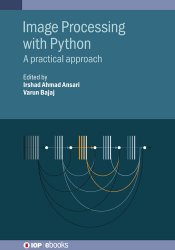Image Processing with Python: A practical approach
- Добавил: literator
- Дата: 17-08-2024, 03:57
- Комментариев: 0
 Название: Image Processing with Python: A practical approach
Название: Image Processing with Python: A practical approachАвтор: Irshad Ahmad Ansari, Varun Bajaj
Издательство: IOP Publishing
Год: 2024
Страниц: 300
Язык: английский
Формат: pdf (true), epub
Размер: 38.2 MB
This book explores the domain of image processing using Python, with the help of working examples and accompanying code. Aimed at researchers and advanced students with a knowledge of image processing fundamentals, this book introduces Python programming via image processing and provides numerous hands-on examples and code snippets. The book will enable readers to appreciate the power of Python in this field, write their own code, and implement complex image processing algorithms such as image enhancement, compression, restoration, segmentation, watermarking, and encryption, and be able to incorporate machine learning models using relevant Python libraries. This book is prepared to meet the needs of young researchers and professionals who are about to start their research journey in the domain of image processing. This book will help readers develop their own applications, whether for software-based implementation or simulation and testing before a final hardware implementation.
Python for image processing applications has grown tremendously due to its open-source nature and excellent library support. Professionals, students, and researchers working in the image processing domain find it helpful to use pre-existing libraries. They can even create their own library and make it available for others to use. These qualities led to an excellent growth in the popularity of Python.
Image processing is quite a complex computation. This can be done efficiently by using matrix-based calculations. In addition, development in Machine Learning and Artificial Intelligence domains also helped the image processing domain grow significantly. In the past, Python has been proven to be an excellent platform for this combination, i.e., Machine Learning-supported image processing.
Python provides many pre-trained machine-learning models. These models can easily be used for different image processing tasks with a small amount of transfer learning. Applications such as image de-noising, character recognition, and image sharpening are a few domains that get affected by this upgrade.
The proposed work attempts to bring together recent trends in the image processing domain and provide hands-on exposure to the readers, students, and researchers working in this domain. This book contains an example-led explanation of image processing applications and machine learning models. Python is used for the implementation work to make this book useful for the masses.
Chapter 1 introduces the different Python libraries and their applications for the image processing domain. Chapter 2 provides a methodological study of image processing operations such as de-noising, image segmentation, edge detection, object recognition, image sharpening, classification, feature detection and matching, analysis, and manipulation of images. Chapter 3 presented a step-by-step process for implementing three different image segmentation techniques using Python. Chapter 4 explored the processes to improve the segmentation of different regions of the images. Therefore, a pre-processing such as adaptation was performed on test images, and then a region-growing algorithm was performed using 8-neighborhood to generate new pixels. Chapter 5 discusses the principles of retinal layer segmentation and elaborates on the design cycle of the deep learning methods for retinal layer segmentation in OCT images. Chapter 6 provides de-noising based on the wavelet soft thresholding technique. Chapter 7 provides comparative evaluations of various Deep Learning architectures, including U-Net, 3D U-Net, V-Net, and nU-Net, revealed that nnU-Net exhibited superior performance in accurately segmenting prostate cancer within the peripheral zone (PZ) and central gland (CG) regions. Chapter 8 describes the working of the Optical Character Recognition to extract the text content of the Image and the implementation of the Convolutional Neural Network.
Скачать Image Processing with Python: A practical approach
Внимание
Уважаемый посетитель, Вы зашли на сайт как незарегистрированный пользователь.
Мы рекомендуем Вам зарегистрироваться либо войти на сайт под своим именем.
Уважаемый посетитель, Вы зашли на сайт как незарегистрированный пользователь.
Мы рекомендуем Вам зарегистрироваться либо войти на сайт под своим именем.
Информация
Посетители, находящиеся в группе Гости, не могут оставлять комментарии к данной публикации.
Посетители, находящиеся в группе Гости, не могут оставлять комментарии к данной публикации.
